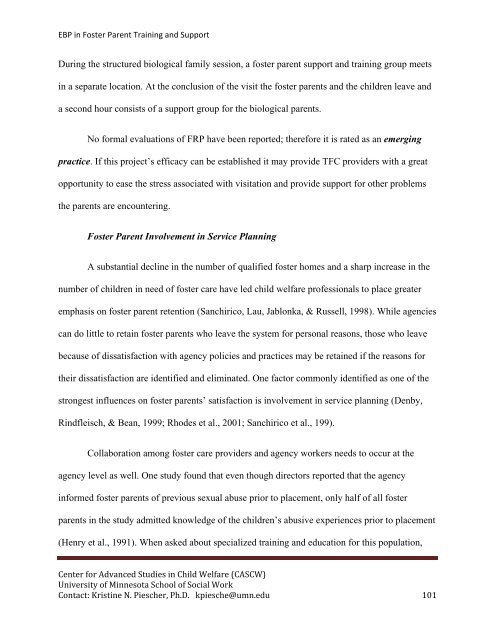Evidence-Based Practice in Foster Parent Training and Support ...
Evidence-Based Practice in Foster Parent Training and Support ...
Evidence-Based Practice in Foster Parent Training and Support ...
You also want an ePaper? Increase the reach of your titles
YUMPU automatically turns print PDFs into web optimized ePapers that Google loves.
EBP <strong>in</strong> <strong>Foster</strong> <strong>Parent</strong> Tra<strong>in</strong><strong>in</strong>g <strong>and</strong> <strong>Support</strong>Dur<strong>in</strong>g the structured biological family session, a foster parent support <strong>and</strong> tra<strong>in</strong><strong>in</strong>g group meets<strong>in</strong> a separate location. At the conclusion of the visit the foster parents <strong>and</strong> the children leave <strong>and</strong>a second hour consists of a support group for the biological parents.No formal evaluations of FRP have been reported; therefore it is rated as an emerg<strong>in</strong>gpractice. If this project’s efficacy can be established it may provide TFC providers with a greatopportunity to ease the stress associated with visitation <strong>and</strong> provide support for other problemsthe parents are encounter<strong>in</strong>g.<strong>Foster</strong> <strong>Parent</strong> Involvement <strong>in</strong> Service Plann<strong>in</strong>gA substantial decl<strong>in</strong>e <strong>in</strong> the number of qualified foster homes <strong>and</strong> a sharp <strong>in</strong>crease <strong>in</strong> thenumber of children <strong>in</strong> need of foster care have led child welfare professionals to place greateremphasis on foster parent retention (Sanchirico, Lau, Jablonka, & Russell, 1998). While agenciescan do little to reta<strong>in</strong> foster parents who leave the system for personal reasons, those who leavebecause of dissatisfaction with agency policies <strong>and</strong> practices may be reta<strong>in</strong>ed if the reasons fortheir dissatisfaction are identified <strong>and</strong> elim<strong>in</strong>ated. One factor commonly identified as one of thestrongest <strong>in</strong>fluences on foster parents’ satisfaction is <strong>in</strong>volvement <strong>in</strong> service plann<strong>in</strong>g (Denby,R<strong>in</strong>dfleisch, & Bean, 1999; Rhodes et al., 2001; Sanchirico et al., 199).Collaboration among foster care providers <strong>and</strong> agency workers needs to occur at theagency level as well. One study found that even though directors reported that the agency<strong>in</strong>formed foster parents of previous sexual abuse prior to placement, only half of all fosterparents <strong>in</strong> the study admitted knowledge of the children’s abusive experiences prior to placement(Henry et al., 1991). When asked about specialized tra<strong>in</strong><strong>in</strong>g <strong>and</strong> education for this population,Center for Advanced Studies <strong>in</strong> Child Welfare (CASCW)University of M<strong>in</strong>nesota School of Social WorkContact: Krist<strong>in</strong>e N. Piescher, Ph.D. kpiesche@umn.edu 101
















